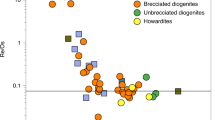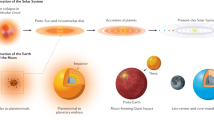Abstract
Saturn’s moon Titan has attracted much attention because of its massive nitrogen atmosphere1, but the origin of this atmosphere is largely unknown. Massive secondary atmospheres on planets and satellites usually form only after a substantial differentiation of the body’s interior and chemical reactions during accretion2,3,4,5,6,7, yet Titan’s interior has been found to be incompletely differentiated8. Here we propose that Titan’s nitrogen atmosphere formed after accretion, by the conversion from ammonia that was already present on Titan during the period of late heavy bombardment about four billion years ago9. Our laser-gun experiments show that ammonia ice converts to N2 very efficiently during impacts. Numerical calculations based on our experimental results indicate that Titan would acquire sufficient N2 to sustain the current atmosphere and that most of the atmosphere present before the late heavy bombardment would have been replaced by impact-induced N2. Our scenario is capable of generating a N2-rich atmosphere with little primordial Ar on undifferentiated Titan. If this mechanism generated Titan’s atmosphere, its N2 was derived from a source in the solar nebula different from that for Earth, and the origins of N2 on Titan and Triton may be fundamentally different from the origin of N2 on Pluto.
This is a preview of subscription content, access via your institution
Access options
Subscribe to this journal
Receive 12 print issues and online access
$259.00 per year
only $21.58 per issue
Buy this article
- Purchase on Springer Link
- Instant access to full article PDF
Prices may be subject to local taxes which are calculated during checkout



Similar content being viewed by others
References
Lunine, J. I. & Atreya, S. K. The methane cycle on Titan. Nature Geosci. 1, 159–164 (2008).
Atreya, S. K., Donahue, T. M. & Kuhn, W. R. Evolution of a nitrogen atmosphere on Titan. Science 201, 611–613 (1978).
McKay, C. P., Scattergood, T. W., Pollack, J. B., Borucki, W. J. & van Ghyseghem, H. T. High-temperature shock formation of N2 and organics on primordial Titan. Nature 332, 520–522 (1988).
Glein, C. R., Desch, S. J. & Shock, E. L. The absence of endogenic methane on Titan and its implications for the origin of atmospheric nitrogen. Icarus 204, 637–644 (2009).
Abe, Y., Ohtani, E., Okuchi, T., Righter, M. & Drake, M. in Origin of the Earth and Moon (eds Canup, R. M. & Righter, K.) 413–433 (Univ. Arizona Press, 2000).
Kuramoto, K. & Matsui, T. Formation of a hot proto-atmosphere on the accreting giant icy satellite: Implications for the origin and evolution of Titan, Ganymede, and Callisto. J. Geophys. Res. 99, 21183–21200 (1994).
Lunine, J. I., Choukroun, M., Stevenson, D. & Tobie, G. in Titan from Cassini–Huygens (eds Brown, R. H., Lebreton, J-P. & Waite, J. H.) 35–59 (Springer, 2009).
Iess, L. et al. Gravity field, shape, and moment of inertia of Titan. Science 327, 1367–1369 (2010).
Gomes, R., Levison, H. F., Tsiganis, K. & Morbidelli, A. Origin of the cataclysmic Late Heavy Bombardment period of the terrestrial planets. Nature 435, 466–469 (2005).
Niemann, H. B. et al. The abundances of constituents of Titan’s atmosphere from the GCMS instrument on the Huygens probe. Nature 438, 779–784 (2005).
Alibert, Y. & Mousis, O. Formation of Titan in Saturn’s subnebula: Constraints from Huygens probe measurements. Astronom. Astrophys. 465, 1051–1060 (2007).
Hersant, F., Gautier, D., Tobie, G. & Lunine, J. I. Interpretation of the carbon abundance in Saturn measured by Cassini. Planet. Space Sci. 56, 1103–1111 (2008).
Barr, A. C., Citron, R. I. & Canup, R. M. Origin of a partially differentiated Titan. Icarus 209, 858–862 (2010).
Zahnle, K., Schenk, P. M. & Levison, H. F. Cratering rates in the outer solar system. Icarus 163, 263–289 (2003).
Griffith, C. A. & Zahnle, K. Influx of cometary volatiles to planetary moons: the atmospheres of 1,000 possible Titans. J. Geophys. Res. 100, 16907–16922 (1995).
Shuvalov, V. Atmospheric erosion induced by oblique impacts. Meteor. Planet. Sci. 44, 1095–1105 (2009).
Lorentz, R. D., McKay, C. P. & Lunine, J. I. Analytical investigation of climate stability on Titan: sensitivity to volatile inventory. Planet. Space Sci. 47, 1503–1515 (1999).
Waite, J. H. et al. Liquid water on Enceladus from observations of ammonia and 40Ar in the plume. Nature 460, 487–490 (2009).
Bockelée-Morvan, D., Crovisier, J., Mumma, M. J. & Weaver, H. A. in Comets II (eds Festou, M. C., Keller, H. C. & Weaver, H. A.) 391–423 (Univ. Arizona Press, 2004).
Iro, N., Gautier, D., Hersant, F., Bockelée-Morvan, D. & Lunine, J. I. An interpretation of the nitrogen deficiency in comets. Icarus 161, 511–532 (2003).
Cruikshank, D. P. et al. A spectroscopic study of the surfaces of Saturn’s large satellites: H2O ice, tholin, and minor constituents. Icarus 175, 268–283 (2005).
McKinnon, W. B., Lunine, J. I. & Banfield, D. in Neptune and Triton (ed. Cruikshank, D. P.) 807–877 (Univ. Arizona Press, 1995).
Brown, M. E. & Calvin, W. M. Evidence for crystalline water and ammonia ices on Pluto’s satellite Charon. Science 287, 107–109 (2000).
Penz, T., Lammer, H., Kulikov, Yu. N. & Biernat, H. K. The influence of solar particle and radiation environment on Titan’s atmosphere evolution. Adv. Space Res. 36, 241–250 (2005).
Mandt, K. E. et al. Isotopic evolution of the major constituents of Titan’s atmosphere based on Cassini data. Planet. Space Sci. 57, 1917–1930 (2009).
Marty, B. et al. Nitrogen isotopes in the recent solar wind from the analysis of Genesis targets: Evidence for large scale isotope heterogeneity in the early solar system. Geochim. Cosmochim. Acta 74, 340–355 (2010).
Yurimoto, H. & Kuramoto, K. Molecular cloud origin for the oxygen isotope heterogeneity in the Solar System. Science 305, 1763–1766 (2004).
Lyons, J. R. & Young, E. D. CO self-shielding as the origin of oxygen isotope anomalies in the early solar nebula. Nature 435, 317–320 (2005).
Charnley, S. B. & Rodgers, S. D. The end of interstellar chemistry as the origin of nitrogen in comets and meteorites. Astrophys. J. 569, L133–L137 (2002).
Lyons, J. R. et al. Timescales for the evolution of oxygen isotope compositions in the solar nebula. Geochim. Cosmochim. Acta 73, 4998–5017 (2010).
Acknowledgements
This study was supported by Grant in Aid from the Japan Society for the Promotion of Science and the Mitsubishi Foundation. Y.S. thanks S. Fukuzaki for help with the experiments and K. Kuramoto, K. Hamano, M. Arakawa, S. Watanabe, V. Shuvalov, C. P. McKay, S. K. Atreya and D. F. Strobel for helpful discussions.
Author information
Authors and Affiliations
Contributions
Y.S. designed the ice target system for the experiments, performed the experiments, modelled Titan’s N2 inventory, and wrote the manuscript. H.G. performed the SPH simulations. T.K. designed the laser-gun system. All the authors discussed and contributed intellectually to the interpretation of the results.
Corresponding author
Ethics declarations
Competing interests
The authors declare no competing financial interests.
Supplementary information
Supplementary Information
Supplementary Information (PDF 2264 kb)
Rights and permissions
About this article
Cite this article
Sekine, Y., Genda, H., Sugita, S. et al. Replacement and late formation of atmospheric N2 on undifferentiated Titan by impacts. Nature Geosci 4, 359–362 (2011). https://doi.org/10.1038/ngeo1147
Received:
Accepted:
Published:
Issue Date:
DOI: https://doi.org/10.1038/ngeo1147



